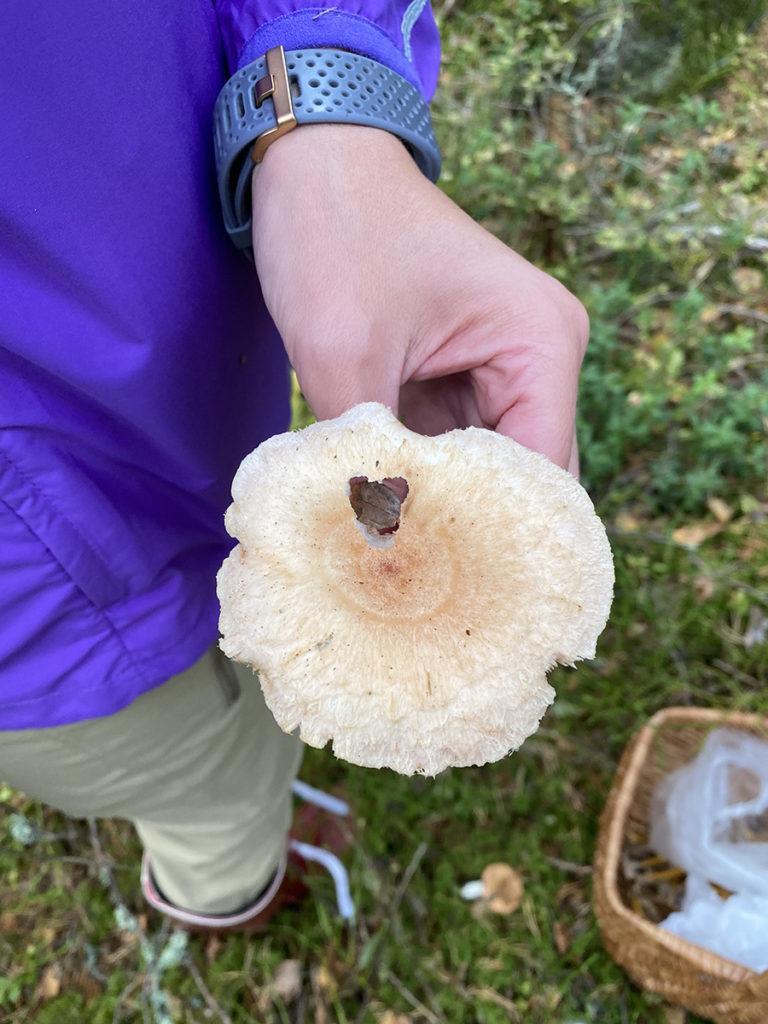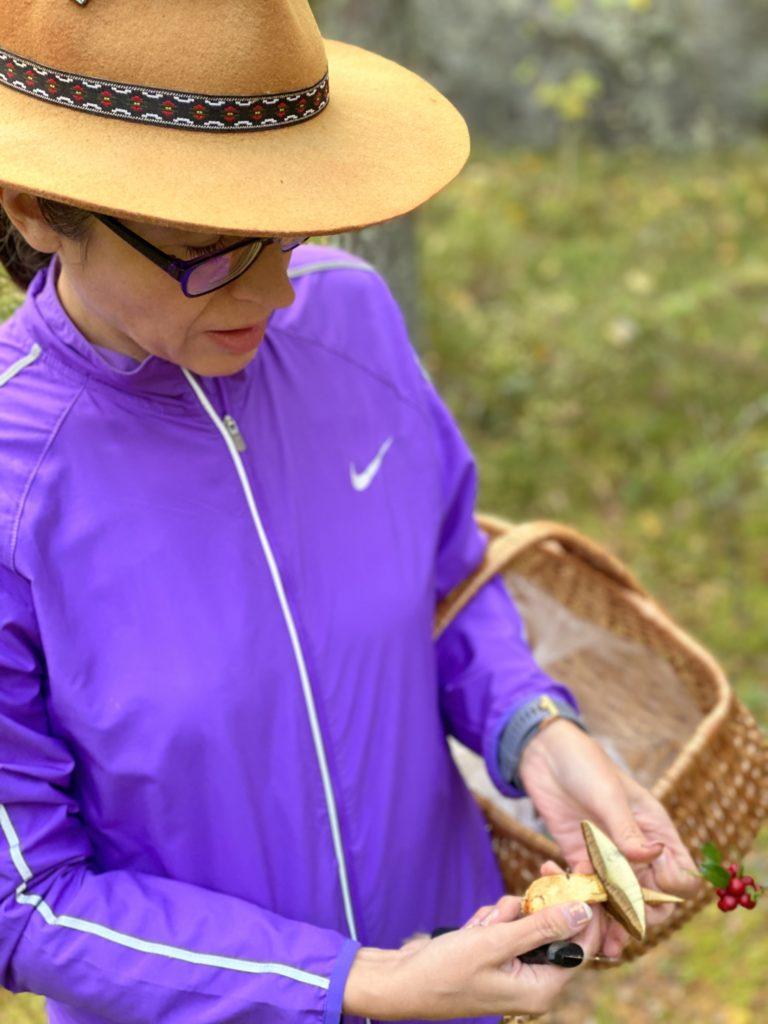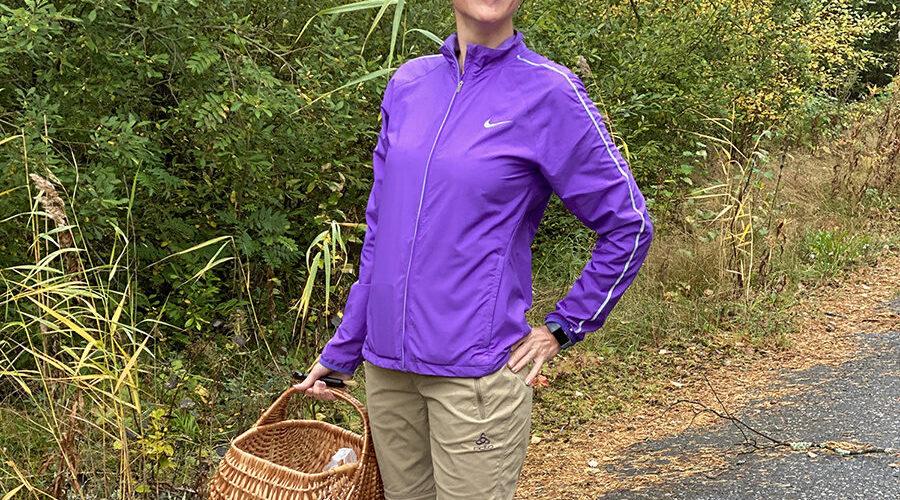A foggy morning is turning into a beautiful autumn day as I find myself following Maisa’s red car on the serpentine roads of Rymättylä. We park our cars on a small footpath and Maisa hands out the necessary equipment: a mushroom knife and a basket.
Maisa is the product and marketing manager at Chemigate. She is also one of my best friends. The kind of friend that if she ever needed one of my kidneys, I would tell her to text me the recipient’s address while I look for a suitable knife.
When I ask her why we stopped right here, she replies that a thick spruce forest is a good place for finding funnel chanterelles: “Put your chanterelle specs on!” When you pick mushrooms long enough, you develop a sixth sense for them. Maisa says that she was once on a cycling trip with friends and suddenly asked everyone to stop, fully convinced that they would find chanterelles in the forest there. And they did.
This moment makes me smile – I have experienced this a few times before, but it always brings the same joy of success. This is the moment when the interviewee really lights up on the subject. The floodgates open and a few terabytes of data about the secrets of mushroom hunting move to the outbox. Maisa learned the basics from her mother. This happened despite the fact that, during her childhood in Pelkosenniemi, mushrooms were mostly considered “reindeer food”.
When I ask her why she has chosen mushrooms of all things, I get the same type of answer that I have heard from other enthusiasts: “Mushrooms are more challenging than berries, finding them is a bit like detective work. Mushrooms are closer to animals than plants. So, they are also highly suitable for carnivores.”
There are also other reasons. Maisa talks about her two complementary worlds. Mushroom hunting belongs to the down-to-earth, northern world. In this world, time loses its meaning, the basic needs of life become emphasised and it is perfectly acceptable to be introverted and withdrawn. I understand that this world includes traditions and keeping them alive. Maisa also moves smoothly in her other environment, the city world. This world is full of schedules and requires an extroverted approach. Here, the values are different. It would be too simplistic and belittling to call this world superficial because success here requires professionalism, competence and an eye for the game. Maisa has these, too.
Maisa does not really have a favourite mushroom but thinks that every edible mushroom can be developed into a dish. The penny bun gives you the best risotto, arched woodwax is good in any dish when dried, and funnel chanterelles make an excellent soup. Finding a beautiful or rare mushroom gives you a special kick.
After picking half a basketful of funnel chanterelles and getting acquainted with the woolly milkcap and slippery jack, we have to pause for a moment for a customer meeting. Nowadays, this is possible even in the middle of nowhere. After establishing connection, I tell them I am in the forest with Maisa. Everyone wants to say hello to Maisa because everyone knows her. It is one of Maisa’s superpowers in the city world: she knows everyone and everyone knows her.

After the negotiation, we head for new hunting grounds. Late summer has been dry in Rymättylä, and there are slightly wetter areas in Merimasku. The terrain we find promises chanterelles, sheep polypore and funnel chanterelles. As we walk in the woods, I ask Maisa about her management philosophy.

After a moment of reflection, she mentions enablement, motivation and the flow of information. She then speaks words that crystallise thousands and thousands of pages of management literature into one sentence: “Make sure nobody is so pissed off that they forget to do their job.” You probably cannot find an embroidery of that, but this does not diminish the strength of the message.
Another moment passes while we examine the mushrooms. I get to taste a little piece of woolly milkcap carefully. Apparently, the pungent chilli pepper taste disappears when you boil the mushroom. After this, the conversation turns to Martin, the newest member of our team. I ask what advice Maisa would give him.
“You should get to know everyone while you’re learning how to do the job. Listening is important.”
We do not find anything to take home from Merimasku. On the way back, I ask Maisa who she would like to challenge. “A little bird told me that Tarja Rintala’s skills are not limited to the workplace. I would like to hear more about her legendary handicrafts.” Well, Tarja, will you accept the challenge?
Maisa’s tips:
- Beginners should start mushroom hunting with a more experienced person. Just using a phone app may cause disappointments that kill the budding interest.
- The Finnish Mycological Society’s Facebook group is also a great help in identifying mushrooms.
- For identification and photography, the mushrooms should be picked with roots and cut in half. Smell is also an important distinguishing characteristic.
- When picking mushrooms, you should clean them in the forest. This makes it a lot easier to handle them at home and also helps to stop insect damage in time. When picking different species, keep them in their separate compartments.
- There are a zillion species of mushrooms in Finnish forests. You can always learn about new species and recipes. You should not keep your focus too narrow.

